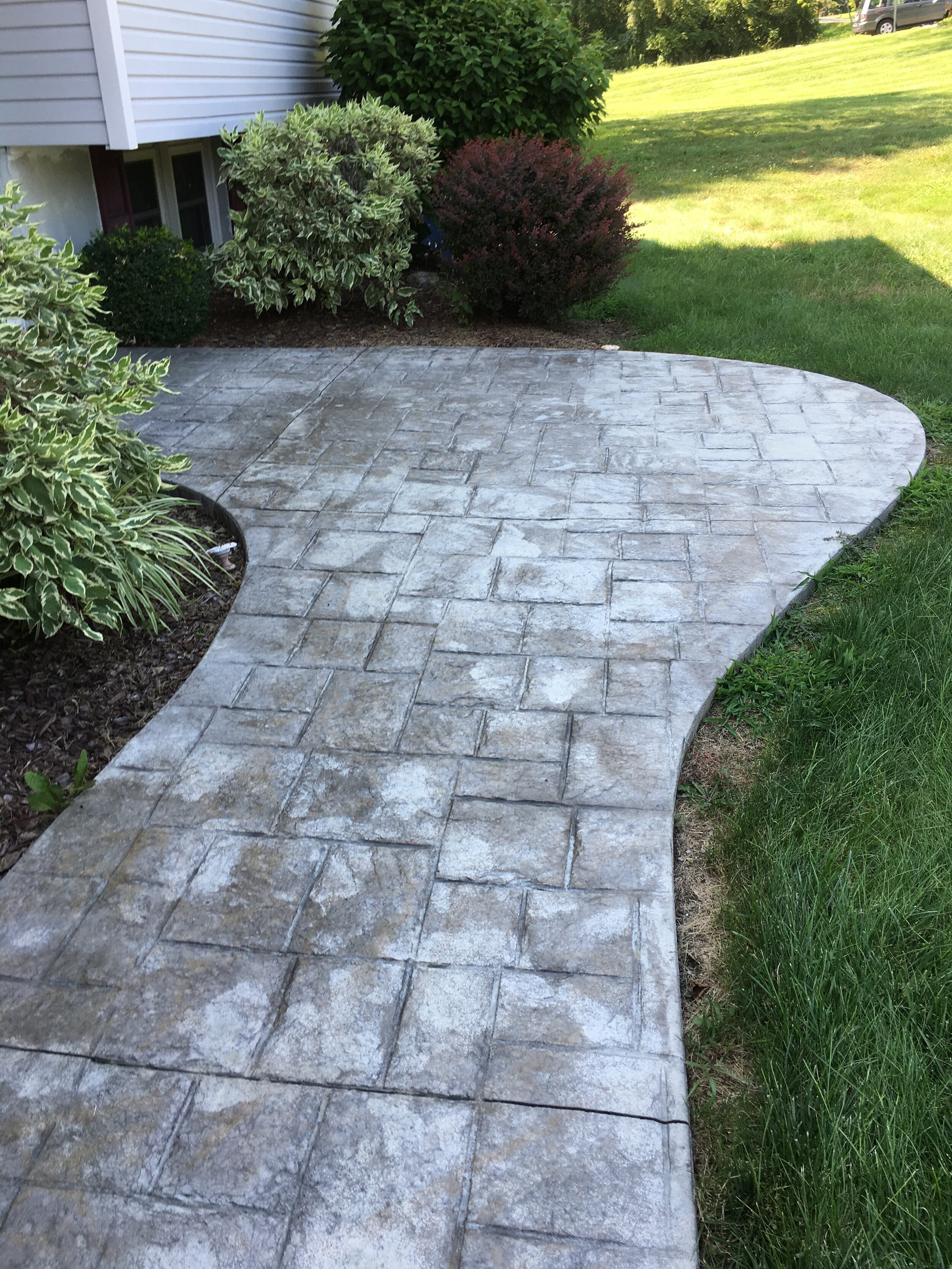The Winter Woes of Decorative Concrete
Winter is here! The changing season can be a beautiful thing to see but it can also wreak havoc on us and our stuff. That includes our gorgeous concrete exteriors. When Spring comes around we discover, to our great disappointment, that our driveways, patios, or sidewalks have lost their beauty. The three main culprits of this horrendous act are called…Scaling, Spalling, and Cracking.
Let’s take a look at each villain then find out why they attack and how to defend our concrete.
Scaling affect on stamped concrete walkway
Scaling
Scaling is the delamination of a thin layer of the concrete’s surface. Thus the word “scaling” because it can often look like thin sheets or “scales” are peeling away from the concrete. Painted, sealed, colored, and stained concrete surfaces affected by scaling will likely be visible as white or light spots.
Spalling
Spalling is a form of damage to the concrete’s surface that extends deeply into the slab, clearly and extensively exposing coarse aggregate.
Cracking
Unfortunately cracking occurs in concrete no matter what. The only thing that concrete contractors can do is use science and math to determine where those cracks are most likely to form and design accordingly. Control joints and expansion joints are implemented to control the cracks that may occur in concrete slab work. If you want more information about why the “concrete guy” cut a nice big line (control joint/expansion joint) right through the middle of your floor click here.
Meanwhile, we’re going to move on to how the winter weather augments the processes mentioned above.
Why it Happens
Scaling, spalling, and cracking can all occur in concrete because of the initial formation process. There are any number of reasons from water-cement ratio within the concrete mix, addition of water to the batch, finishing practices, curing conditions, to air-entrainment that may cause these conditions. The initial process is out of the homeowners or property owners hands. But! There are things that homeowners and property owners can do after the concrete is finished to care for the concrete and keep it looking fabulous.
A combination of sub-freezing temperatures, moisture, and temperature fluctuation above and below the freezing point (freeze-thaw cycling) are the main reasons that scaling, spalling, and cracking become exposed. When movement at a joint exceeds tolerance, the adjacent sections of a slab may be forced to shift and/or contract. Spalling and/or cracking is almost a foregone conclusion when this happens.
What to Do
So, what can we do? We can’t prevent the temperature from increasing and decreasing. We can’t stop the elements from throwing wind, rain, snow, sleet, and beating sun onto our outdoor artwork. But here are a few tips that may help us preserve our exterior concrete.
Snow left to melt can refreeze if the temperature drops.
Ditch the metal snow shovel. Go, buy a plastic-blade snow shovel. The plastic is less abusive than a metal edge which can scrape and chip your concrete.
Snowblowers. Just stop. Most of them have screws or metal parts underneath that drag. If you can’t shovel your driveway and the snowblower is absolutely necessary, try to keep the use to a minimum.
Do not use ice-melters and rock salts. Instead, use clean sand or cheap clay kitty litter. Why? Because anything that melts snow by chemical reaction is also reacting with your concrete surface. Many of the products will state that they are “concrete safe” but will have a warning posted elsewhere about not using the product on new concrete or concrete less than two years old. If sealed properly, salt is ok. But use caution! Unless you are certain that your concrete is sealed properly and with salt resistant sealer, it is better to use clean sand. Do not use beach sand which contains reactive sodium and calcium based salts.
Get that snow and ice cleared off as soon as possible. You do not want it to melt and refreeze and melt and refreeze thus increasing the impact of the freeze-thaw cycle. Some people advise leaving the snow to insulate the concrete and letting it melt away naturally. However, if the snow does not melt away completely and very quickly it could, as mentioned before, refreeze. The temperature is going to get to that concrete whether the snow covers it or not. So better to just get it off quickly.
If you want your concrete resealed do it at a frequency of once every 2 to 3 years and only if needed. Avoid reseals during the winter months. Also do not opt in to do this yourself. Either contact the original contractor for the job or get another professional. They will recognize the surface conditions, know how to prepare the surface, perform the best product application, and know what products to use along with how to dilute them.
If there is still damage to your concrete, it is probably because of the initial process or because it is simply worn and needs a face lift. At this point, the best decision would be to reach out to an expert for help in determining what can be done to fix your concrete’s blemishes.


